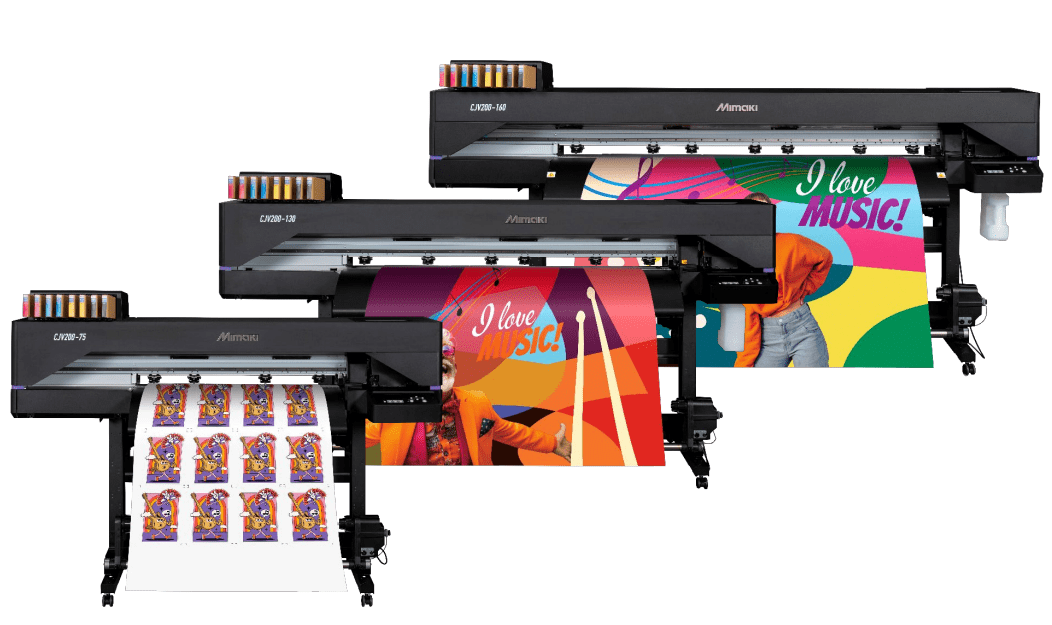How do you find customers? How do you keep them? How do you make your company stand out from the rest and ensure it keeps growing? For any print business, addressing these challenges is key to success. In this guide, we’ll show you how.
Achieving growth isn’t easy for any business. What’s certain, however, is that businesses that succeed tend not to do so by accident. That’s certainly true for print businesses. If you want to give your printing company the greatest chance of growth, you’ll need to know far more than the technical nuts and bolts of print management. You’ll need to understand the market, your customers and your staff. You’ll need to know what makes a great sales proposition, how to turn that proposition into leads and how to convert those leads into sales.
And even when you’ve done all that, you’ll need to keep your eyes open for opportunities to diversify. How do you manage all that? With our guide to growing and improving your digital print company.
- How to sell print services
- How to market your print business
- How to generate print sales leads
- How to write a proposal for printing services
- How to recruit the right staff for your print shop
- How to cut costs through print production management
- Choose the right print management software
- Make your print business more sustainable
- Diversify your print business

How to sell print services
There’s a problem in selling print. With so many print businesses delivering similar products in similar ways at similar prices, printers have tended to fall back on tried and tested ways of selling that fail because they don’t offer anything different or distinctive.
It’s not enough to offer “competitive prices”, “quick turnarounds” and “quality service” because there’s not a single print company that doesn’t set out to offer those things.
So how can you sell your print company in a way that really drives growth?
In this post, we explore a different approach to service that can differentiate what you do and make you stand out to your customers. You might think of it as service+.
Service+
i) Service + solutions
‘Solutions’ may be a much overused word, but solving problems for customers is always going to be welcomed. That could be a major print innovation that solves a tricky issue they were facing, but it doesn’t have to be anything quite so profound. Finding ways to reduce or remove effort and complication from their day can be just as valuable.
ii) Service + capability
Capability is another differentiation technique that can help grow your printing business. This is selling based on expertise and is of particular value for printers who have access to niche skills or equipment that can help them deliver results others can’t.
iii) Service + expertise
Not every customer wants to dig into the detail of print stocks and eco-inks. But some, especially those from an allied industry like branding and marketing, might value your ability to recommend one product or technique over another to deliver better results for their client.
The more often you do that, the quicker you become their trusted source of reliable advice.
Leverage your service
When elements of your service really do standout – when you are your clients’ go-to source of trusted print know-how, support or solutions – they can be a powerful way to grow your print business.
Discover more about how to sell print services
How to market your print business
If you want to grow your printing business, you’ll need to tell your prospective client base about who you are and what you can do for them. But where do you start? Here are the three crucial first steps…
i) Identify your ideal customers
You can’t pitch your print services to everyone. Nor would you want to. So the starting point for your marketing strategy should be to understand who your preferred customers are.
You probably have a clear view of this already. You know the clients with whom you enjoy a great working relationship, who bring you interesting work, who may be demanding but never ask the impossible, and who pay on time. And you know the ones who don’t.
Into this mix, you might also want to add clients in a sector you haven’t previously worked, or clients who operate at a higher budget level.
Take a moment to consider your preferred customers. Who do you love working with? What makes them an ideal client?
Jot down two or three ideal customers and the reasons you love working with them.
Now begin building a list of prospective customers that match your preferences.
ii) Identify customer wants and needs
Put yourself in your clients shoes and imagine how they might answer the following question: why do they choose you? Why do they stay with you?
Your immediate response might be that they get a good price, or that your turnaround times are fast, but they can get those from lots of printers – so what is it that they don’t get other printers? What made them leave their last printer to come to you? What do they truly value about you?
iii) Make your proposition distinctive
When every printer has the same proposition, there’s nothing to make you stand out. So what’s your point of difference?
At Soyang, one of our key differentiators is our ability to offer a print solution for every surface at any scale. Every printers’ USP (unique selling point) will be different. Yours may be the technology you use, your expertise in a particular niche or your sustainability credentials.
Whatever you identify as your distinctive proposition, it’s important that, in addition to it being distinctive, it should also fit with the wants and needs of your customers identified above.
Your answer to the above questions will enable you to:
- Identify a set of prospects or customer types to approach
- Understand their needs
- Create a distinctive proposition that grabs their attention by addressing their needs
Now you’re on the way to marketing your print company in a way that delivers results.
Discover more about how to market your print business
How to generate print sales leads
You’ve identified your target market and you’ve developed a distinctive proposition to appeal to them. Now you need to engage them. That’s what generating sales leads is all about.
Sales leads are like oxygen for any growing print business. Providing you’re able to convert those leads with a sound proposal (see below) a constant supply will keep the business buoyant and drive its growth. But where do you begin?
The following steps assume that you have already identified your target market, identified their needs and developed a proposition that demonstrates how you meet those needs.
i) Create a sales funnel
The value of a sales funnel is that it:
- Helps you understand where your prospects are in the lead development process (that is, are they cold prospects you’re contacting for the first time or hot prospects who are ready to commit to choosing you?)
- Ensures your lead generation activities are appropriate to the target’s position in the funnel
- Ensures you don’t miss opportunities
Example: You issue a blanket email to all the targets you’ve identified about a fantastic deal you’re offering on large format stretch textile printing. You believe all your targets will be interested in this product, but without understanding the sales funnel you’ll limit your chances of success.
That’s because, although some of your targets will know who you are, will understand the product and know about your capabilities, others won’t. Sending everyone an email about a special offer will only appeal to those who already have the knowledge that enables them to commit. Understanding your sales funnel will help you separate your audiences into those who only need the nudge of an offer to buy (i.e. they’re at the decision or action part of the funnel), from those who first need some product education, or need an introduction to you (i.e. they’re only at the awareness stage, much higher up the funnel).
Remember, you’ll also need to plan follow ups and nudges to capture those who were interested in what you had to say, but then got distracted.






ii) Choose the right lead generation methods
Once you understand your target audience you’ll understand what communication methods are most likely to connect with them. The channel you choose is important. There is, for example, little point building a major profile on Facebook if your clients are all on LinkedIn. Certain channels can also help you at specific stages of the sales funnel.
Potential channels worth investigating may include:
- Organic SEO (that is, ensuring your website ranks highly on Google for specific keyphrases)
- Paid search (that is, paying for Google Ads that prominently place your company in the rankings
- Social media (as noted above, it’s worth doing research to understand which social media platform your prospects use)
- Networking
- Exhibiting at expos, conferences and other
- Advertising in local press, tv or radio
- Direct mail
Although used far less widely than it once was, direct mail may be of particular value to a growing print company. An early funnel approach, it enables you to introduce your skills in an immediate and tangible way.
iii) Don’t neglect existing customers
It’s easy to become so involved with finding new customers that you neglect the ones you already have. Maintaining regular contact with existing customers is not only a simple way of maintaining a regular pipeline of work; it costs far less than generating new print leads too.
Stay in touch using an occasional, personalised email, a newsletter, by sending a promotional merchandise gift or by hosting events and inviting your regular clients to them.
How to write a proposal for printing services
Your work in developing leads has delivered results. But you’re not over the line yet. Now, you’ll need to submit a proposal that reminds your prospect of why they need to do business with you.
IMPORTANT: If you’ve jumped to this part of the ‘How to grow your printing business’ guide without considering the earlier sections, do that now. You’ll need the insights you developed in those sections to complete this one successfully.
What is a print proposal?
Yes, it’s a basic question, but it’s one that’s worth revisiting as a reminder that a proposal is not merely a list of the services you’ll provide and the price you’ll charge for them. A proper proposal goes beyond these basic details to provide:
- Client objectives
- Services you’ll provide
- Price
- The timescales you’ll work to
- The terms and conditions of your business
- A company overview, with a reminder of why you are the ideal printer to work with
- Print samples
- Testimonials
- Next steps
Let’s consider some of those in a little more detail:
i) Tailor your template
Yes, you’ll want to set up a template proposal with common elements included (T&Cs, for example) to speed up the proposal writing process. But remember to tailor each proposal so it’s personal to the individual prospect. That means doing more than simply replacing the names. It means taking time to restate their goals and explaining how you’ll meet them.
ii) Create pricing with ‘wriggle room’
A single flat fee presents a prospect with a ‘take it or leave it’ situation, and if they don’t feel there’s a reasonable chance of negotiation, the chances are they’ll leave it. Instead, offer three price options covering a low, medium and high service level. This will not only improve your chances of hitting an acceptable price point but will also indicate that you’re likely to be up for negotiating a bespoke price/service that falls somewhere between those bands.
iii) Be memorable
One of the key parts of a proposal is your company overview. That’s not a cue for you to share your Wikipedia page, but it is a chance for you to connect the client’s goals with your capabilities. Use the answers you developed in ‘How to sell your print services’ and ‘how to market your print services’ to create a to-the-point section that clearly demonstrates that you’re the right choice.
iv) Stick to the point
How long should a print services proposal be? There’s no fixed rule, but remember, your clients are almost inevitably short on time. Always aim to be brief while ensuring you’ve covered all the bases noted above. The golden rule: say only as much as you need to say, then stop.
v) Next steps
At the end of your proposal, give your reader a helpful nudge as to what to do next. The easier you make it – for example, an e-signature box that gets the ball rolling immediately – the more likely they’ll do it.






How to recruit the right staff for your print shop
There’s no single factor that can make growing and improving your printing business easy. But of all the ingredients, nothing is more important than your people.
Launching a print business will always demand effort, but when the only member of staff to worry about is you, at least one element of the job is relatively simple. As a print company grows, however, it needs more people to do the work. And that presents print company owners/leaders with a critical challenge: how do you ensure you recruit the right people?
The print recruitment golden rule
It’s not just about skills. Clearly, it’s important that the people you hire have the capability to do the job. But bear in mind that printing skills can be taught. Other attributes – like problem solving, leadership, diligence, attention to detail, the ability to get on with the rest of the team and the ability to project a great impression of your business to customers – can’t.
The golden rule, therefore, is to recruit people who can help improve your print business. Here are some ways to achieve that.
i) Choose brand ‘fit’
Experience is always valuable but you’ll want to strike the right balance, finding someone who may come with great ideas but who will also suit your way of doing things without rocking the boat too much.
Look at your potential recruits and ask ‘who will fit in well here?’
ii) Go to the tree, not the barrel
Want new recruits who are willing to learn your ways of doing things? Consider apprenticeships and build links with your local colleges. That way, you’ll be able to mould talent to fit your business.
iii) Ask your existing staff
Who in the business already exemplifies the traits you want from your new recruits? Talk to those people about the attributes they would want from their colleagues, the skills and experience they believe would benefit the business, and the job ad content that would encourage them to apply.
iv) Make your job ad stand out
Do a quick trawl of existing print business recruitment ads and you’ll find they all start to merge into one. There’s very little to separate the businesses or the role from any other. That’s because, typically, printers will either use a recruitment agency that uses a job ad template, or they’ll look at what’s already online and feel they should follow suit.
But that won’t make your ad distinctive. To do that…
- Talk informally, simply and to the point
- Use language that differs from the rest. When every other ad asks for ‘proactive self starters’, rephrase it to say what you really want: ‘people who don’t wait to be told what to do – they just do it’
- Stress the things that make the job or your business stand out
- Take advice from your staff (see above)
- If you offer an impressive benefits package, shout about it
- Emphasise opportunities for development, training and leadership
How to cut costs through print production management
It’s a fine balancing act. Cut costs too much and the results will show in your end product. But without taking an active approach to your print production management, you run the risk of costs inflating and efficiency decreasing. This is how improve your print business through careful production management.
The following examples (taken from a traditional book/brochure/magazine printing perspective) demonstrate just how easy it can be to find significant print production efficiencies when you look at each task with a critical and creative eye.






Four simple ways to reduce the cost of your printing
i) Print in mono
Yes, you’ll want to include a significant splash of colour across your publication to deliver the required visual punch, but does every page need to be in colour? By reserving colour for certain sections you not only reduce print production costs; you ensure each colour splash really does stand out.
ii) Recommend against textured print stock
Every print company knows that textured stock, as lovely as it looks and feels, increases print time and costs, and can lead to inconsistent print quality (because of the inherent inconsistencies of textured printed material).
Encouraging customers to choose embossing or laminating helps lower everyone’s costs, keeps you in control of the end finish, and still looks fabulous.
iii) Choose the small print
We don’t mean font sizes, but opting for a 240 x 167mm print (as opposed to A4) for your brochure, magazine or catalogue will still give you an impressive looking book while enabling much greater cost-efficiency.
iv) Use tints not coloured print stock
Coloured print stock just feels inherently grand, and it’s always tempting to use it for prestige print projects. But holding varied stock colours costs money. As a cost saving alternative, print on standard white stock before adding a tint.
In addition to the savings, you’ll enjoy more accurate colour reproduction by printing onto a white rather than coloured background.
Choose the right print management software
The right large format printing software can be a valuable helping hand in improving your print business. Here’s why.
i) Tracking and analysis
There’s waste in your print business and it’s costing you in terms of materials, time, energy and staff resource. The challenge, of course, is finding it. Print management software constantly monitors your processes, your spend and who’s spending it. Then analytical tools enable you to compare one project, department or client with another to give you greater visibility over:
- Workflow issues
- Print volumes
- Device performance
- Waste
- Costs
The insights provided by the software can enable you to shift strategy in a range of ways, from reducing bottlenecks to client chargebacks, so its easier to stay efficient and ensure nothing gets missed.
ii) Constant oversight
Your print management software is effectively an automated print manager, able to keep a close watch on your print equipment while the actual print manager is busy organising the flow of printed materials.
The software automatically monitors your print devices, ordering ink, monitoring system performance and installing software updates so you don’t have to. The software will also alert you when it detects a fault or when a service is due, enabling you to call in maintenance before small issues become major problems.
iii) Security
Modern print management software incorporates a range of security measures, some to protect internet-connected printers from security threats, others to ensure sensitive material is only released to authorized persons.
Make your print business more sustainable
Sustainability is not the same thing as ‘environmentally friendly’. Low carbon, low waste, ‘green’ products are part of a sustainable offering, but there’s more to it than that. So the first thing for any growing print business to determine is what facets of sustainability will you make your own?
The simplest starting point is to consider the UN Sustainable Development Goals (SDGs).
What are the SDGs?
As the UN notes, the 17 goals were established to “improve health and education, reduce inequality, and spur economic growth – all while tackling climate change and working to preserve our oceans and forests.”
You’re likely to feel that your business can affect some SDGs considerably more than others. Climate action, life below water (and the prevention of plastics entering our oceans), responsible consumption and good health and well-being are just some of the goals that many print businesses might feel they can influence.
How can the SDGs help grow and improve your printing business?
Aligning your print company with the SDGs brings a range of benefits:
i) Working more efficiently
There’s a common misconception that sustainability costs. Yet while some measures might involve an upfront cost, there can often be dramatic savings down the line (e.g. switching to LED-only lighting or solar power). Thinking about how to work more sustainably can be a powerful driver for finding new ways to work more cost-effectively too.
ii) Improved tendering
Increasingly, large organisations expect their supply chain to be on board with sustainability. The faster you make changes, the quicker you can make your sustainable initiatives part of your print company’s tendering exercises.
iii) Better recruitment
Workers want to work for companies that work responsibly. In this report, 65% of staff said they “would be more likely to work for a company with robust environmental policies”. Similar reports demonstrate this employee goodwill extends beyond the environment to other areas of social responsibility.
iv) Customers like it
It’s true that, when it comes to sustainability, customers sometimes say one thing and do another (as this report into the retail sector notes) but it’s also clear that, over the medium term, companies adopting sustainable policies are more likely to win customer share.






Diversify your print business
One thing’s for sure: however your print business started out, the chances are it won’t remain that way. Understanding when and how to diversify your operation is a key part of how to grow your print business. Here are some key considerations.
i) The standard model of print diversification
Currently printing business cards and brochures? Why not expand your offering to workwear, exhibition material, vehicle wraps or more? This is the ‘standard model’ of print diversification which essentially amounts to applying your print skills to other materials.
There’s nothing wrong with this approach although, as it’s the one most frequently adopted by print businesses, it’s an approach that won’t always deliver the hoped for results unless you also deliver something truly standout in each of your new product/service areas.
ii) Diversification beyond print
A more radical model of print diversification is to look at services associated with but separate from print. There are plenty of examples of print companies that diversified and grew by expanding to make branding, marketing and web services part of their offering.
Again, this is a perfectly viable way to improve and grow your print company but, as each additional service requires a different skillset and setup, it can also add cost pressures as you need to recruit and equip.
iii) Diversification doesn’t have to mean ‘bigger’
Diversification can take a narrower view. By opting for specialisation, a print company can become the acknowledged expert in its particular field. At Soyang, for example, our ‘niche’ became wide and grand format printable materials.
Diversification through specialism brings certain benefits:
- You’re already an expert – you don’t have to build new skillsets (or recruit) to deliver a new set of services.
- Generally speaking, a niche approach enables you to control costs more easily than a generalist approach.
- Your specialist knowledge and expertise becomes a key selling point of the business, one which customers value and may not be able to find elsewhere.
This form of diversification doesn’t necessarily mean you shrink the overall number of products and services you offer. Take a look at our product range and you’ll find dozens of products, from wall coverings to mesh banners to outdoor floor coverings. But each product fits our carefully defined area of expertise.










